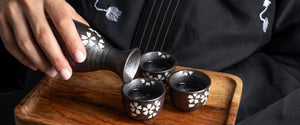Unlocking the legacy beverage of Japan
Dec 19, 2023
Unlocking the legacy beverage of Japan: A Comprehensive Guide to Sake Sake, this legacy Japanese national drink, is deeply rooted in tradition, craftsmanship, and a rich cultural heritage expressed through meticulous brewing techniques. Crafted from rice, water, yeast, and koji mold, each sip is a harmonious blend of flavors. Let’s explore its origins, the artistry of its production, and the universal appeal that has made it a global sensation.
What is Sake?
At its core, sake is a Japanese rice wine crafted through the intricate process of fermentation. It stands out as a unique and versatile beverage, distinct from its Western counterparts. Sake embodies a delicate balance of flavors, often described as crisp, slightly sweet, and with an underlying umami richness.
What is Sake Made Of?
The four fundamental ingredients of sake are simple yet pivotal. Rice, water, yeast, and koji mold come together in a harmonious dance orchestrated by skilled brewers. The type of rice used, the water source, and the brewing methods contribute to the varied expressions of sake.
What is Sake to Japan?
Sake is more than just a beverage; it's a cultural emblem ingrained in Japanese traditions. It holds a significant place in ceremonies, celebrations, and daily life. Served in a range of temperatures from chilled to warm, sake's diverse forms cater to different palates and occasions.
What is Sake Alcohol Content?
One key aspect that sets sake apart is its alcohol content. While wine typically falls within the 9-16% alcohol by volume (ABV) range, sake can vary widely. Most sake lands between 15-20% ABV, providing a robust kick in a relatively small serving. This characteristic makes sake a potent yet nuanced drink.
What is Sake in Relation to Wine?
Despite being called "rice wine," sake differs significantly from grape wine in terms of production and flavor. Sake's unique brewing process involves converting starches in rice into sugars, which are then fermented into alcohol. Unlike wine, which relies on the natural sugars in grapes, sake requires an additional step to break down the rice starches.
What is Junmai Sake?
Junmai, a term often associated with sake, signifies a pure rice brew. To be classified as Junmai, the sake must be crafted without the addition of distilled alcohol. This results in a more pronounced rice flavor, giving enthusiasts a chance to savor the essence of the rice and the brewer's skill.
Sake is a multifaceted and culturally significant beverage with a history as rich as its flavor profile. As we've uncovered the basics — from its composition to its role in various settings — we've only scratched the surface of the world of sake. In future explorations, we'll dive deeper into sake classifications, food pairings, and the evolving global appreciation for this Japanese elixir. Stay tuned for more insights into the captivating universe of sake. Cheers!



